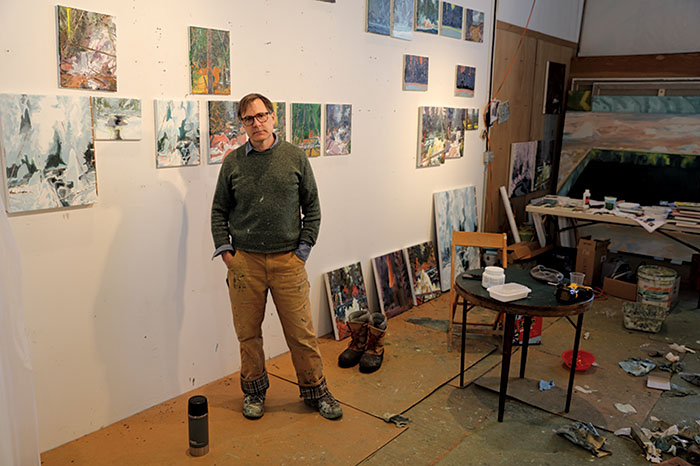Studio Visit: Eric Aho
Vermont’s Saxtons River rises in wetlands on the eastern slopes of the southern Green Mountains. Thirty-five miles north of Brattleboro, it spills across the tiny town that bears its name, where artist Eric Aho has been painting rivers—not just the Saxtons but its various mill ponds and tributaries, nearby Sackett’s Brook, and the still more distant rivers of his youth.

As a motif, the river emerged as “a force outside myself,” he told me, one that allowed for an emotionally resonant response. In his newest paintings, it’s a force pulsing with ever-changing visual density, charged with memory, and evocative of the enigmatic rhythms of painting itself.
“Everything came to a dead stop in March [due to the pandemic].” He gestures to a row of 14 x 11″ paintings tacked up behind him. “It didn’t feel right to go on making large paintings when everything was feeling like it was turning inward, going within.”
Putting aside the outsize gestures of bravura painting, Aho has been taking snowy walks in the woods with his eleven-year-old lab, Ellie, and coming back to the studio to paint small canvases from memory. He paints in part of an old school gymnasium that’s still got lines on the floor and retractable basketball hoops on the walls; yet he’s using a diminutive easel that last year he commissioned a carpenter friend to build but which he hadn’t had a chance to use until now.

“What I’m doing now is trying to have present-mindedness,” Aho says. “I’m just making this painting—and it isn’t spoken for, no one’s asking for it,” he says. Working at a less frenetic pace has opened up new ways of being present to painting and a sense of renewed honesty and immediacy. “I want to surprise myself,” he says. “It’s a different approach and a different kind of attention.”
Aho’s newer, smaller paintings are at once observational, spontaneous, and as steeped in memory as they are in geometry. They’re as likely to depict Saxtons River as the New Hampshire rivers and brooks he explored as a boy, or the WWII battlefields and remote forested cabins he’s experienced on trips to France, Finland, and other parts of Europe.
“I think I do see the painting ‘out there’ when I’m looking at nature,” Aho says. “But I’ve been trying not to think about the painting or about what nature is” when at the easel. “I came across this word in Walt Whitman, what he calls “unminding.” It points to “a particular way of being present,” Aho says, “a looking without disturbance.”
The word appears in Whitman’s poem “Sparkles from the Wheel,” which describes a group of children standing quietly on a noisy city street watching the sparks fly from a knife-grinder’s wheel. Whitman calls the children “an unminded point, set in a vast surrounding,” and sees himself, “effusing and fluid—a phantom curiously floating,” actively “absorb’d and arrested” with the same quality of receptive attention as the children, meanwhile all around them pounds “the loud, proud, restive bass of the streets.”
For Aho, it’s not the city but the vaster and in a way “louder” expanse of nature’s wildness that surrounds the rapt observer and somehow makes its way onto the canvas. “It comes back to feeling—it’s a response,” he says. “It’s not quite accurate to talk about seeing closely; it’s more apt to say, ‘I felt closely. I allowed myself to feel what happens out there.’” And what does happen out there? “Sometimes I see it in sharp detail, and sometimes in total chaos, and sometimes I see it as both at the same time,” he says. “I want the painting to reflect that.”
Ultimately, “you paint the way you live in the world,” he concludes. “Honesty is the key component.” It isn’t about truth to nature or even, as in Cezanne, truth to sensation. In the end, “the object on the wall is the truth,” Aho says. “I’m not making a picture of a thing, I’m making an equivalent of nature. It’s not a mood, it’s not even an emotion—that’s my grand secret ambition—to make something that’s an element of nature, an independent force all by itself.”
And for now, at least, that’s small paintings “made simply” on a modest wooden easel inside a gymnasium after walks with his dog. Because that’s what painting is: “It’s a strange and bizarre and incredibly wonderful project.”
